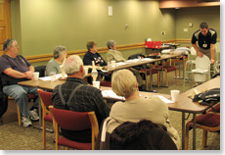
Learning occupational therapy techniques for joint replacement recovery

Practicing physical therapy exercises in preparation for joint replacement recovery
Considering a joint replacement?
McLaren Central Michigan and Central Michigan Orthopaedics (Drs. Lilly and Moutsatson) have partnered to offer a new comprehensive joint replacement program. The Central Michigan Joint Replacement Program offers an all-inclusive, planned course of treatment for individuals who undergo a total joint replacement with a strong focus on wellness, not sickness.
This comprehensive program focuses heavily on education and group support techniques for the joint replacement patient. This philosophy of care has been shown to increase patient satisfaction and safety, and return to daily activities is much quicker.
Educational seminars are held monthly and available for anyone scheduled for surgery or interested in learning more about a total joint replacement. The free seminars take place at McLaren Central Michigan Wellness Central building, 2600 Three Leaves Drive in Mt. Pleasant.
For more information, or to sign up for a seminar, please contact Program Coordinator Beth Nesbitt, BSN, RN at (989) 779-5651.
Joint Replacement Program Phases
Phase 1: Pre-operative
- After meeting with the orthopedic surgeon and making the decision to have a total joint replacement, patients are scheduled to attend a free educational seminar four to six weeks prior to surgery at McLaren Central Michigan. This same seminar is also available to anyone interested in learning more about total joint replacement. Seminars are offered twice monthly.
- During the seminar, patients and their "coach" (spouse, family member, or friend) will receive a comprehensive handbook as well as information covering topics such as anatomy, preconditioning, rehabilitation, infection prevention, and the hospital process.
- Patients must have required labs, testing and medical/cardiac consults completed a few weeks prior to surgery.
- Patients learn strength-building exercises. Performing these exercises prior to surgery will help to strengthen the muscles around a weak joint, making movement after surgery easier.
Phase 2: At the hospital
- Patients report to the hospital on the day of surgery and are admitted into the hospital following their joint replacement surgery.
- As rehabilitation begins, patients will wear their own clothing and are encouraged to eat and exercise with other joint replacement patients in a group. Physical therapists will instruct patients on proper use of a walker, and how to get in and out of a bed, chair, and car. Occupational therapists also offer instruction on how to get dressed and safely transfer from a shower or a toilet.
- Joint replacement patients will see the Program Coordinator at least once a day.
- A case manager works with each patient to discuss discharge plans and continued care needs at the end of the hospital stay. Options for continued rehabilitation are explained and may include home health care services, outpatient rehabilitation or "short stay" inpatient rehabilitation in a skilled nursing facility with a rehab unit. Case managers also assist in obtaining durable medical equipment such as walkers and shower chairs necessary to provide for a safe and functional home environment.
Phase 3: Post-Operative
- Physical therapy is usually required three times a week for about two weeks. In most cases, this rehabilitation takes place outside of the hospital. However, other inpatient arrangements can be made.
- Patients will receive a follow-up phone call at two weeks, 30 days, 90 days and six months after surgery by the Program Coordinator to check on progress and to answer any questions.